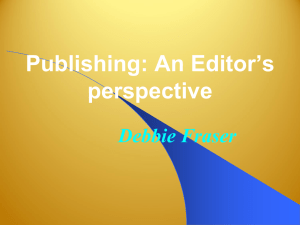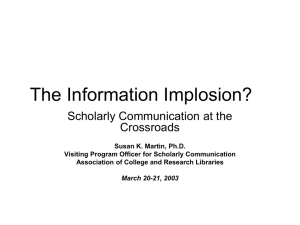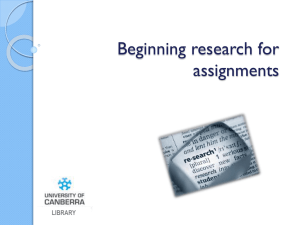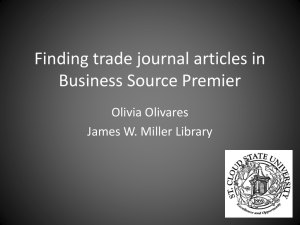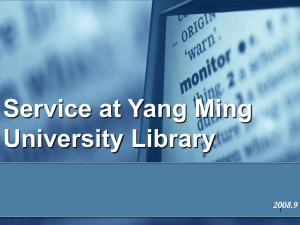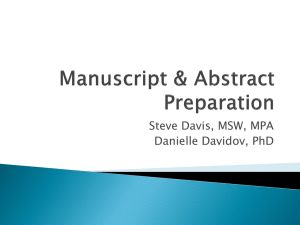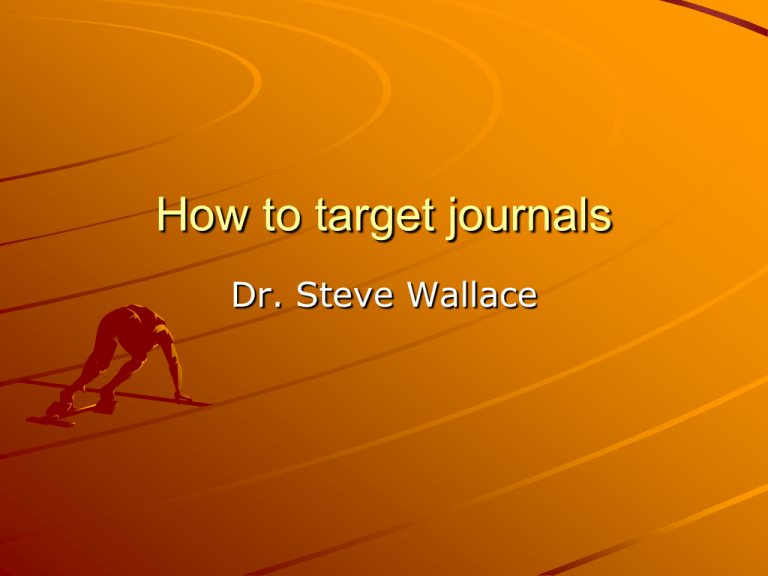
How to target journals
Dr. Steve Wallace
Outline of speech
Review journal guidelines to determine what kind
of papers journals are looking for.
Avoid two things in a paper that always make
reviewers angry
Use an academic social network to increase your
chance of acceptance
Identify journals with rising and falling impact
factors
Cite references politely to earn better reviews.
Identify the three types of academic journals
Select and target journals while identifying those
where you probably won’t be accepted.
Collect a pool of potential journals for each
article
For each paper, collect a pool of
potential journals.
1) Do not submit two papers to the
same journal in two months,
especially if the two articles are
related.
2) Editors prefer to publish two
articles by different authors.
3) Better for your CV
Collecting your pool
Keywords
Relatedness metrics
References
Scopus
Aims and scope
Editor’s letter
Reviewing the journal
Send your research where you have the
highest probability for publication.
Sometimes journals have biases and
preferences
Subject matter: Empirical,
Theoretical papers?
Check past issues of the journal.
How many Chinese names can you
find?
Preferences are known; biases are
difficult to detect.
Practice
Pick journals like you pick stocks
Do homework on journals.
Submit paper to a journal with a rising
impact factor and higher acceptance rates.
avoid declining journals with low
acceptance and diminishing impact factor.
Could cause the journal to be removed
from the SSCI and SCI ranking.
Practice
Identifying journals with rising impact factors
Good specialty journal’s impact factors are rising.
General journal’s impact factor, except for a few
at the top, are expected to decline
In general journals, "readers are confronted with
a decreasing probability of finding at least one
important article in their field." (Holub, Tappeiner,
and Eberharter, 1991).
In the 1970s, the top ten journals in every field
were general journals.
In the 1990s, half of the top ten journals were
specialized journals.
How do journals compare to each
other?
Journal Citation Reports, published
annually by the Institute for
Scientific Information in Philadelphia,
Pennsylvania, provides statistical
information about all established
journals.
Total Citations
Total Citations (TC) is the number of all
citations papers in the journal during a
year. A large TC may indicate a journal's
dominance in the field.
A large TC is also characteristic of
multidisciplinary journals (such as Nature)
and journals catering to broad fields (such
as Journal of Geophysical Research).
A small TC may indicate a journal's
weakness or less frequent publication.
However, it is also typical for narrowspecialty journals even of high quality.
Cited Half-Life
Cited Half-Life (CHL) is the number of
journal publication years going back from
the current year which account for 50% of
the total citations received by the cited
journal in the current year.
It indicates the age of its average cited
articles. A large CHL may imply longevity
of the published information.
However, a relatively small CHL may
reflect a journal's emphasis on cutting
edge research and its timeliness.
Impact Factor
Impact Factor (IF) is the ratio between the
number of all current citations of source items
published in a journal during the previous 2 years
to the total number of articles that the journal
published during that time.
It can also be viewed as the frequency with which
the "average article" in the journal has been cited
in a particular year.
It is also believed to be a fair quality measure
that "tends to discount the advantage that large,
frequently issued, older journals have over
smaller, less frequently issued, newer journals"
[McDonnell, 1997].
Practice
Approach different types of journals
Sending all papers to top journals is
risky
Sending all papers to low-quality
journals is unsatisfactory
Quantity and quality important.
Having three papers in different
journals is better than three in one
journal, if the relative quality of the
journals is the same.
Questionable publishing outlets
Chapters in edited volumes
Non peer reviewed academic journals
Graduate student journals
Note journals
Review journals
Local journals
New Journals
Electronic journals
Non SCI journals
Preferred publishing outlets
Regional journals
Newer journals
Interdisciplinary journals
Field journals
Disciplinary journals
Problems of Journals
Association journals: Editors change every few
years, and usually accept more papers from
colleagues and friends. Since the editors are
chosen from a few major institutions, they get a
larger share of publications. They are subsidized
by associations. (AER, Econometrica, IEEE,
ACM)
University journals: Universities protect their own
interests. Will often have a stated preference for
their own teachers’ and students’ papers.
Subsidized by universities. (HBR, MIT Sloan)
Commercial journals: Least likely to have
preferences or biases. Subsidized by reader
subscriptions. (Blackwell, NorthHolland,Elsevier )
Reviewing journals (1)
Is the journal peer reviewed?
Is the journal in the recommended
publishing outlet category?
Does the Journal have a solid reputation
and reputable publisher?
How old is the journal?
Is the journal carefully produced?
Does the journal come out on time?
Are the authors published in its pages
diverse?
Reviewing journals (2)
Does the journal publish more than five or
six articles a year?
Is the Journal online or indexed
electronically and where?
Does it take a long time to get published
once you submit your manuscript?
Is the Journal going through a transition?
Who reads the Journal?
Matching your article to the journal
Does the Journal have a upcoming theme
or special issue on your topic?
Does the Journal have word or page
length limits you can meet?
Does the style of your article match the
journal style?
Do you know any of the journal editors?
How does your journal require articles to
be submitted?
Things to ask the assistant editor
How many submissions a year does
your journal receive?
What is your journal’s turnaround
time?
What is your journal’s backlog?
Elements of a query letter to the
Editor
Address editor by name
Any human connections
Why he should be interested
Display a knowledge of the journal
Your title and abstract
Article’s length
Not been published before
Grants or awards
Potential problem to tease review
Emeraldinsight Journals
Emma Hollindrake, External Relations Assistant
“Don’t forget that you can always e-mail
an editor outlining your proposed paper
(sending just the abstract is best) to see if
they think your paper is suitable (if you
have three possible journals, send the
outline/abstract to all three Editors!); they
are usually more than willing to offer
advice and will often suggest an
alternative journal is they feel their
journal is not the best one for your paper.”
Query letter to editor
One of the best things you can do to
improve chances of acceptance
Four responses
“Send it in” – time pressure
Mini review with little problems
Negative response
No response
Keep a record of your
publications
Some effective researchers use a
“research log” to:
1) Know when to send a reminder to the
editor
2) Prevent resubmission of a rejected
paper to the same journal and
3) Avoid multiple submission of several
papers to the same journal within a short
period of time.
Submission guidelines: Worth the
trouble
Following the Instructions to Authors
reduces the chances of the
manuscript being rejected by the
journal editors even before the
process for peer review.
Editors don’t like to see a paper that
has been correctly prepared for a
competing journal
Reasons for major revision or rejection of Taiwanese
journal papers
Faulty methodology
Inadequate references
7%
7%
4%
Poor quality supporting figures
9%
16%
Outside the scope of journal
Not enough contribution to field
7%
2%
Authors did not follow manuscript instructions
Poor writing style and use of English
Title not representative of study
Subject of little novel interest or not generally
applicable
8%
English Errors
27%
13%
How to understand the Journal’s
Instructions to Authors
The Instructions to Authors contain the
journal's expectations about:
the type of articles accepted
the required format for each type of article
type of illustrations
(photographs/tables/figures)
language
publishing charges (if any)
any other instructions about the journal
Topic of submission
First article of new editor
Last article of the year
Aims and Scope
Types of articles acceptable to
the journal
Letters to the Editor,
short communications,
full-length research papers,
review articles
Pre-submission letter to the
editor
Required or not?
English Level
British or American English
British vs US spelling
Generally, American journals require US
spelling and British journals require British
spelling, but many accept either form as
long as the spelling used is consistent
Haematoma vs hematoma
Analysed vs analyzed
Labelling vs labeling
Behaviour vs behavior
Formatting style for the main
text
Most journals set a limit on the
number of words
number of pages
font size (10-, 11-, or 12-point size)
line spacing (usually double-spaced).
right margin or unjustified.
single column or double column format
page numbers
Some journals such as Nature provide templates
to be used for formatting the manuscript.
The format for the title page
Journals differ in their requirement for the title
page.
Most journals specify that the title page should
be typed on a separate sheet of paper and should
include the
title of the article
author’s name
academic degrees
address and university or institute
word count
name of the person for correspondence
The format for the abstract
The journal specifies the
number of words permitted (usually
from 250–350 words),
the content expected in the abstract,
whether the IMRAD format needs to
be followed,
whether it needs to be typed on a
separate sheet of paper.
The number of keywords required
Keywords are required to help find of
the article by search engines on the
Internet.
Most journals specify the number of
keywords they require, ranging from
5 to 10 in number. They are usually
included after the abstract.
The format for the references
The style to be followed when
writing the references with examples
for:
cited papers
cited books
cited book chapters
The format for tables
The Instructions specify the
number of tables permitted
the method to be followed for numbering
word count limit for the titles of tables
whether a hard copy of the tables is required
Most journals request that tables be numbered
in the order in which they appear in the paper
and that the position of the table in the text be
clearly mentioned.
The format for the figures and
photographs
number of figures and photographs.
black and white photographs or color
The size of the figures,
captions and numbering
file formats accepted,
publication charges,
hard copy of figures and photographs is required
whether figures and photographs should be
embedded in the text file or submitted as
individual files, or embedded at the end of the
text file.
whether the photographs should be printed on
glossy or matt paper.
Instructions about equations,
Units, and statistics
Most journals provide instructions on
math and equations in the text
rules for writing Units (usually SI
Units are recommended)
guidelines on presenting statistics
Style guide for symbols
Most journals specify styles to be
used for:
abbreviations and
symbols
drugs
brand names of drugs
microbial names
Method of submission acceptable
to the journal
Submission of the manuscript can be
on paper, on a compact disc, or
electronically.
Manuscript file formats
Commonly requested in MS Word or WordPerfect,
Some journals accept submissions in LaTex, PDF,
EPS, Text, Postscript, or RTF format.
If a PDF document is accepted for publication, a
Word or WordPerfect document will be required.
Some journals specify file sizes (individual files
usually should not exceed 1 KB) and file naming.
These should be followed carefully, to avoid
delays in the review process or rejection
Type of review process followed
The journal usually mentions the
process followed for review of the
submitted manuscript.
If a double-blinded review is to be
carried out, authors are requested to
ensure that their identities are not
revealed.
Publication charges
Some journals may charge for all the
pages but others may publish a fixed
number of pages free and charge
only for publishing any pages over
this number.
Color photographs are charged for,
as well as illustrations/figures
exceeding the permitted number.
Cover letter requirments
Journals such as JAMA, which
provide very comprehensive
Instructions to Authors, even specify
what is required in the cover letter
accompanying the manuscript.
Cover Letter
Don’t send a letter saying little more
than “please find my manuscript
attached”. Your paper does not look
important
The cover letter is your chance to
talk to the editor of your target
journal.
Explain to the editor why your
findings are important and why they
should be published
Cover Letter
General rules for cover letters:
Address to an editor by name
Provide your title and publication type
Provide a brief background, rationale and
description of results
Explain the significance of your findings and why
they would be of interest to the journal’s target
audience
Check the journal’s instructions to ensure that all
requirements have been complied with
Provide corresponding author details
Waiting for the Journal’s
decision
Causes of quick rejection:
Back-log
Previous paper on subject
Editor doesn’t like topic or style
Types of Journal acceptance
Pure accept: almost never happens
Revise minor problems and resubmit:
signs of this are the editor mentioning a
certain date for publication, adding
references, developing conclusion, or
defining terms.
Revise major problems and resubmit:
chance of acceptance 50%. Sometimes
will go back to reviewers sometimes to
editor. Signs are the editor won’t say the
article is conditionally accepted.
When should you start contacting
the editor?
After three months once a month
Four months twice a month
Six months every day
The longer the review takes, the less
chance you have a publishing-reviewers
may be negative
Internal fighting in Journal
You may want to consider withdrawing to
another journal
Editor’s feedback is key in making this
decision
Reminder e-mail to editor
“I’m just e-mailing to inquire about
the status of my article titled______,
which I submitted to your journal on
( date ).”
Don’t get angrier over time, just
keep sending the same e-mail more
often
Sometimes editors appreciate the
reminder
Editor’s letter for a major
revision
“Enclosed please find the reviewers’ report on your paper.
One reviewer has minor recommendations for revision, the
other has fairly substantial recommendations. Although
their reports are very positive about your paper, they also
include helpful suggestions for improving the paper,
especially regarding______. Because of the reviewers
concerns, I cannot accept the paper in its present form. I
can offer, however, to send a revised version of the paper
back to the second reviewer, should you wish to read work
your argument substantially in line with these reports and
resubmit the paper to us. I am sorry to have to convey
what I know will be disappointing news, but I do feel
strongly that with careful revision this essay could be
accepted for publication in our journal.”
Editor’s letter for major revision
I am sorry to have to return your
manuscript because it falls outside our
guidelines. However, we would like to
invite you to resubmit your article. In
order to conform to our guidelines, you
would need to be formulate your article to
clarify your thesis and re-situate the piece
within a more scholarly background.
Thank you for considering our journal and
we look forward to hearing from you.
Rejected but can resubmit
Comes with reviewer comments
Editor may say it will be treated as a
new submission
Editor’s letter can be difficult to
decode
Reject but resubmit
Editors don’t really expect to see
your paper again
Maybe they are just being polite
If reviewer comments are helpful,
you may consider it
Rejected but can resubmit
Enclosed please find the reviewers reports
on your paper. They agree that you have
a very promising idea, but that serious
revision is necessary. In particular, they
would like to see_______. Given their
concerns, I cannot accept the paper for
publication in its current form. Should you
feel able to address our concerns and
submit a substantially revised version of
the paper, I would be glad to ask the
reviewers to read the paper again.
Rejected but can resubmit
“Given the reviewers reports, we
cannot accept your paper for
publication. Should you choose to
revise the paper thoroughly
according to the reviewer’s
substantial recommendations and
submit it again to us, we will send it
to new reviewers.”
Rejected but can resubmit
“Although the reviewers thought the
article was strong, they have noted
some serious flaws that must be
addressed before the article is
publishable. Please see the attached
for the reviewers suggestions.”
Rejected
“Is not publishable”
“Is not ready for publication”
“Cannot be published at this time”
“Does not meet our standards for
publication”
“Is not right for us”
Positive language is not a sign of a
second chance
Rejected paper
“I’m sorry to return your article, but
our submission guidelines require
that articles reveal something new
and demonstrate a thorough grasp of
previous criticism on the topic. Your
submission lacks this dimension and
therefore we cannot consider it
further at this time.”
Rejected paper
“Thank you for offering us your
manuscript we have read it with
interest and regret that we cannot
accept it for publication. We hope
that the attached readers report
provides helpful advice as you revise
your paper for publication in another
journal.”
Rejected by editor
“good luck”
No peer review
Very fast
Reasons: backlog, too many articles
on topic, reviewers report to hostile,
Don’t ask for report just move on to
plan B.
Everyone gets rejected
Your options:
Abandon the article.
Send the article with no changes to
another journal.
Revise the article and send it to
another journal.
Protest the decision and try to
resubmit the article to the rejecting
journal
Avoid the journals which consistently
reject your papers
Temporarily avoid journals which always reject
you
The editor still remembers bad comments about
your papers.
Wait until a new editor is appointed.
If you think there is prejudice on the basis of sex,
race, or nationality, you may consider using
initials instead of spelling out the first and
middle names.
First and middle names, as well as last name,
often reveal the sex, race, or nationality of
the authors.
You may write your full name after the paper is
accepted.
For More Information
www.Editing.tw
www.seminars.tw
Michaelson, Herbert, How to Write & Publish Engineering Papers and Reports, Oryx
Press, 1990. Chapter 6 discusses abstracts.
Bob Bly, Research papers for dummies, Wily and Sons Ltd, 2004
Kwan, a Publishers Handbook, University of Illinois http://www.roie.org/
Robert W. Bly, The White Paper Handbook, Thomson, 2006
How to write and publish an academic paper in 16 weeks
How to attend, speak or present a poster at an academic conference
How to speak confidently in public in 18 weeks – by Steve Wallace


